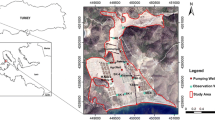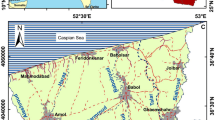Abstract
A numerical assessment of seawater intrusion in Gaza, Palestine, has been achieved applying a 3-D variable density groundwater flow model. A two-stage finite difference simulation algorithm was used in steady state and transient models. SEAWAT computer code was used for simulating the spatial and temporal evolution of hydraulic heads and solute concentrations of groundwater. A regular finite difference grid with a 400 m2 cell in the horizontal plane, in addition to a 12-layer model were chosen. The model has been calibrated under steady state and transient conditions. Simulation results indicate that the proposed schemes successfully simulate the intrusion mechanism. Two pumpage schemes were designed to use the calibrated model for prediction of future changes in water levels and solute concentrations in the groundwater for a planning period of 17 years. The results show that seawater intrusion would worsen in the aquifer if the current rates of groundwater pumpage continue. The alternative, to eliminate pumpage in the intruded area, to moderate pumpage rates from water supply wells far from the seashore and to increase the aquifer replenishment by encouraging the implementation of suitable solutions like artificial recharge, may limit significantly seawater intrusion and reduce the current rate of decline of the water levels.
Résumé
Un bilan numérique de l'intrusion de l'eau souterraine à Gaza, Palestine, a été réalisé au moyen d'un modèle 3D d'écoulement des eaux souterraines à densité variable. Une simulation par différences finies à deux niveaux a été utilisée en régime permanent et transitoire. Le code SEAWAT a été utilisé pour simuler l'évolution spatiale et temporelle des hauteurs piézométriques ainsi que les concentrations en solutés dans l'eau souterraine. Une grille régulière aux différences finies et des cellules de 400 m2, et douze couches horizontales constituent le modèle. Ce dernier a été calibré en condition de régime permanent et régime transitoire. Les résultats de la simulation indiquent que les schémas proposés simulés simulent avec succès les mécanismes d'intrusion. Deux schémas de pompages ont été définis pour prédire, grâce au modèle calibré, à prédire les changements des niveaux d'eau et des concentrations dans l'eau souterraine, sur une période de 17 ans. Les résultats montrent que l'intrusion de l'eau de mer pourrait s'aggraver dans l'aquifère, si les pompages actuels se poursuivent à ce niveau. L'alternative, éliminer le pompage dans la zone d'intrusion, serait de modérer les taux de pompages des puits de production éloignés de la cote et d'accroître le réapprovisionnement de l'aquifère en encourageant l'application de solutions telles que la recharge artificielle, qui limiteraient significativement l'intrusion des eaux souterraines et déduiraient le taux actuel de déclin des niveaux d'eau.
Resumen
Se ha logrado una evaluación numérica de la intrusión de agua salada en Gaza, Palestina aplicando un modelo de flujo 3-D de densidad variable de agua subterránea. Se utilizó un algoritmo de simulación de diferencia finita de dos etapas en modelos de régimen permanente y transitorio. Se utilizó el código de computación SEAWAT para simular la evolución espacial y temporal de presiones hidráulicas y concentraciones de soluto de agua subterránea. Se eligió una malla regular de diferencia finita con una celda de 400 m2 en el plano horizontal en adición a un modelo de 12 capas. El modelo se ha calibrado bajo condiciones de régimen permanente y transitorio. Los resultados de la simulación indican que los esquemas propuestos simulan exitosamente el mecanismo de intrusión. Se diseñaron dos esquemas de bombeo para utilizar el modelo calibrado para predecir los cambios futuros en niveles de agua y concentraciones de soluto en el agua subterránea para un periodo de planificación de 17 años. Los resultados muestran que la intrusión de agua de mar empeoraría en el acuífero si los ritmos actuales de bombeo de agua subterránea continúan. La alternativa de eliminar el bombeo en el área de intrusión, a ritmos de bombeo moderado de pozos de abastecimiento de agua alejados de la costa, a incrementar el reabastecimiento mediante el estímulo de implementar soluciones disponibles como recarga artificial puede limitar significativamente la intrusión de agua de mar y reducir el ritmo actual de descenso de niveles de agua.






















Similar content being viewed by others
References
Aharmouch A, Larabi A (2004) 3-D finite element model for seawater intrusion in coastal aquifers. In: Proceedings of 15th international conference computational methods in water resources, North Carolina
Andersen PF, Mercer JW, White HO (1988) Numerical modeling of saltwater intrusion at Hallandale, Florida. Ground Water 26:619–630, 23(2):293–312
Calvache ML, Pulido-Bosch A (1994) Modeling the effects of salt-water intrusion dynamics for a coastal karstified block connected to a detrital aquifer. Ground Water 32(5):767–771
CISS/WRC (1997) Geophysical study of the southern sector of the Gaza Strip (Khan Younis area). Italian cooperation South (CISS-Palermo) and Water Research Center (WRC Alazhar University-Gaza), Palestine
Dan J, Greitzer Y (1967) The effect of soil landscape and Quaternary geology on the distribution of saline and fresh water aquifers in the Coastal Plain of Israel: Tahal Water Planning for Israel, Publ. 670, Tel Aviv
Das A, Datta B (1995) Simulation of density dependent 2-D seawater intrusion in coastal aquifers using nonlinear optimization algorithm. In: Proceedings of American Water Resource Association of annual summer symposium on water resource and environmental emphasis on hydrology and cultural insight in Pacific Rim. American Water Association, Herndon, VA, pp 277–286
EPD/IWACO-EUROCONSULT (1994) Gaza environmental profile, part one: inventory of resources. Environmental Planning Directorate (EPD), Ministry of Planning and International Cooperation (MOPIC), Palestine
Essaid HI (1990) A multi-layered sharp interface model of coupled freshwater and saltwater in coastal systems: model development and application. Water Resour Res 27(7):1431–1454
Fitzgerald R, Riordan P, Harely B (2001) An integrated set of modeling codes to support a variety of coastal aquifer modeling approaches. In: Proceedings of first international conference saltwater intrusion in coastal aquifers, Morocco
Galeati G, Gambolati G, Neuman SP (1992) Coupled and partially coupled Eulerian-Lagrangian model of freshwater-seawater mixing. Water Resour Res 28(1):147–165
Gangopadhyay S, Gupta AD (1995) Simulation of salt-water encroachment in a multi-layer ground water system, Bangkok, Thailand. Hydrogeol J 3(4):74–88
Ghassemi F, Chen TH, Jakeman AJ, Jacobson G (1993) Two and three-dimensional simulation of sea water intrusion: Performances of the “SUTRA” and “HST3d” models. AGSO J Austr Geol Geophys 14(2/3):219–226
Ghassemi F, Jakeman AJ, Jacobson G, Howard KWF (1996) Simulation of sea water intrusion with 2D and 3D Models: Nauru Island Case Study. Hydrogeol J 4(3):4–20
Giménez E, Morell I (1997) Hydrogeochemical analysis of salinization processes in the coastal aquifer of Oropesa (Castellón, Spain). Environ Geol 29:118–131
Guo W, Bennett GD (1998). Simulation of saline fresh water flows using MODFLOW. In: Proceedings of MODFLOW '98 conference at the International Ground Water Modeling Center, Golden, Colorado, vol 1, pp 267–274
Guo W, Langevin C (2002) User's Guide to SEAWAT, A computer program for simulation of three-dimensional variable density groundwater flow: techniques of water-resources investigations Book 6. U.S. Geological Survey
Huyakorn PS, Anderson PF, Mercer JW, White JRWO (1987) Saltwater intrusion in aquifers: development and testing of a three dimensional finite element model. Water Resour Res 23(2):293–312
Lambrakis N, Kallergis G (2001) Reaction of subsurface coastal aquifers to climate and land use changes in Greece; modeling of groundwater re-freshening patterns under natural recharge conditions. J Hydrol 245:19–31
Langevin CD (2001). Simulation of ground-water discharge to Biscayne Bay, southeastern Florida. U.S. Geological Survey Water-Resources Investigations Report 00–4251
Langevin CD (2003) Simulation of submarine groundwater discharge to a marine estuary: Biscayne Bay, Florida. Ground Water 41:758–771
Larabi A, De Smedt F (1994) Solving 3-D hexahedral finite elements groundwater models by preconditioned conjugate gradient methods. Water Resour Res 30(2):509–521
Larabi A, De Smedt F (1997) Numerical solution of 3-D groundwater flow involving free boundaries by a fixed finite element method. J Hydrol 201:161–182
Martínez DE, Bocanegra EM (2002) Hydrogeochemistry and cation-exchange processes in the coastal aquifer of Mar Del Plata, Argentina. Hydrogeol J 10(3):393–408
McDonald MG, Harbaugh AW (1988) A modular three dimensional finite-difference ground-water flow model. U.S. Geological Survey techniques of water resources investigations, Book 6
Mercer JW, Larson SP, Paut CR (1980) Simulation saltwater interface motion. Ground Water 18(4):374–385
Moe H, Hossain R, Fitzgerald R, Banna M, Mushtaha A, Yaqubi A (2001) Application of 3-dimensional coupled flow and transport model in the Gaza Strip. In: Proceedings of first international conference on saltwater intrusion in coastal aquifers (SWICA), Morocco
PCBS (1998) Population data for the Gaza Strip. Palestinian Central Bureau of Statistics (PCBS), Palestine
Petalas CP, Diamantis IB (1999) Origin and distribution of saline groundwaters in the upper Miocene aquifer system, coastal Rhodope area, northeastern Greece. Hydrogeol J 7(3):305–316
Polo JF, Ramis FJR (1983) Simulation of salt water-fresh water interface motion. Water Resour Res 19(1):61–68
Putti M, Paniconi C (1995) Finite element modeling of saltwater intrusion problems. In: Springer-Verlag (ed) Advanced Methods for Groundwater Pollution Control. International Centre for Mechanical Sciences, New York, 364, pp 65–84
PWA (1997a) Water level monitoring network review. Palestinian Water Authority (PWA), Palestine
PWA (1997b) Water quality monitoring network review. Palestinian Water Authority (PWA), Palestine
PWA/CAMP (2000) Coastal aquifer management program (CAMP)/final model report (task 7). PWA, Palestine
PWA/USAID (2000) Summary of palestinian hydrologic data 2000—volume 2: Gaza. Palestinian Water Authority (PWA), Palestine
Qahman K, Larabi A (2003a) Identification and modeling of seawater intrusion of the Gaza Strip Aquifer—Palestine. In: Proceedings of TIAC03 international conference, Alicante, Spain, vol 1, pp 245–254.
Qahman K, Larabi A (2003b) Simulation of seawater intrusion using SEAWAT code in Khan Younis Area of the Gaza Strip aquifer, Palestine. In: Proceedings of JMP2003 international conference, Toulouse, France
Qahman K, Zhou Y (2001) Monitoring of seawater intrusion in the Gaza Strip, Palestine. In: Proceedings of first International Conference on saltwater intrusion in coastal aquifers, Morocco
Rivera A, Ledoux E, Sauvagnac S (1990) A compatible single-phase(two-phase numerical model: 2. Application to a coastal aquifer in Mexico. Ground Water 28(2):215–223
Sadeg SA, Karahonglu N (2001) Numerical assessment of seawater intrusion in the Tripoli region, Libya. Environ Geol 40:1151–1168
Stuyfzand PJ (1999) Patterns in groundwater chemistry resulting from groundwater flow. Hydrogeol J 7(1):15–27
Voss CI (1984) SUTRA, saturated–unsaturated transport a finite simulation model. USGS, Reston, Virginia, U.S.A
Xue Y, Xie C, Wu J, Liu P, Wang J, Jiang Q (1995) A three dimensional miscible transport model for sea water intrusion in China. Water Resour Res 31(4):903–912
Yakirevich A, Melloul A, Sorek S, Shaat S (1998) Simulation of seawater intrusion into the Khan Yunis area of the Gaza Strip coastal aquifer. Hydrogeol J 6:549–559
Zheng C (1990). MT3D: A modular three-dimensional transport model for simulation of advection, dispersion and chemical reactions of contaminants in groundwater systems. Report to the U.S. Environmental Protection Agency, Ada, Oklahoma
Zhou X, Chen M, Wan L, Wang J, Ning X (2000) Numerical simulation of sea water intrusion near Beihai, China. Environ Geol 40:223–233
Acknowledgments
This work was done at LIMEN, Ecole Mohammadia d'Ingénieurs (EMI) and supported primarily with research funds from UNESCO/KEIZO OBUCHI Fellowship Program. Additional support was made from of the SWIMED project under contract number ICA3-CT2002-10004 funded by EU on behalf of Gaza Islamic University partner-Palestine.
Author information
Authors and Affiliations
Corresponding author
Rights and permissions
About this article
Cite this article
Qahman, K., Larabi, A. Evaluation and numerical modeling of seawater intrusion in the Gaza aquifer (Palestine). Hydrogeol J 14, 713–728 (2006). https://doi.org/10.1007/s10040-005-003-2
Received:
Accepted:
Published:
Issue Date:
DOI: https://doi.org/10.1007/s10040-005-003-2




